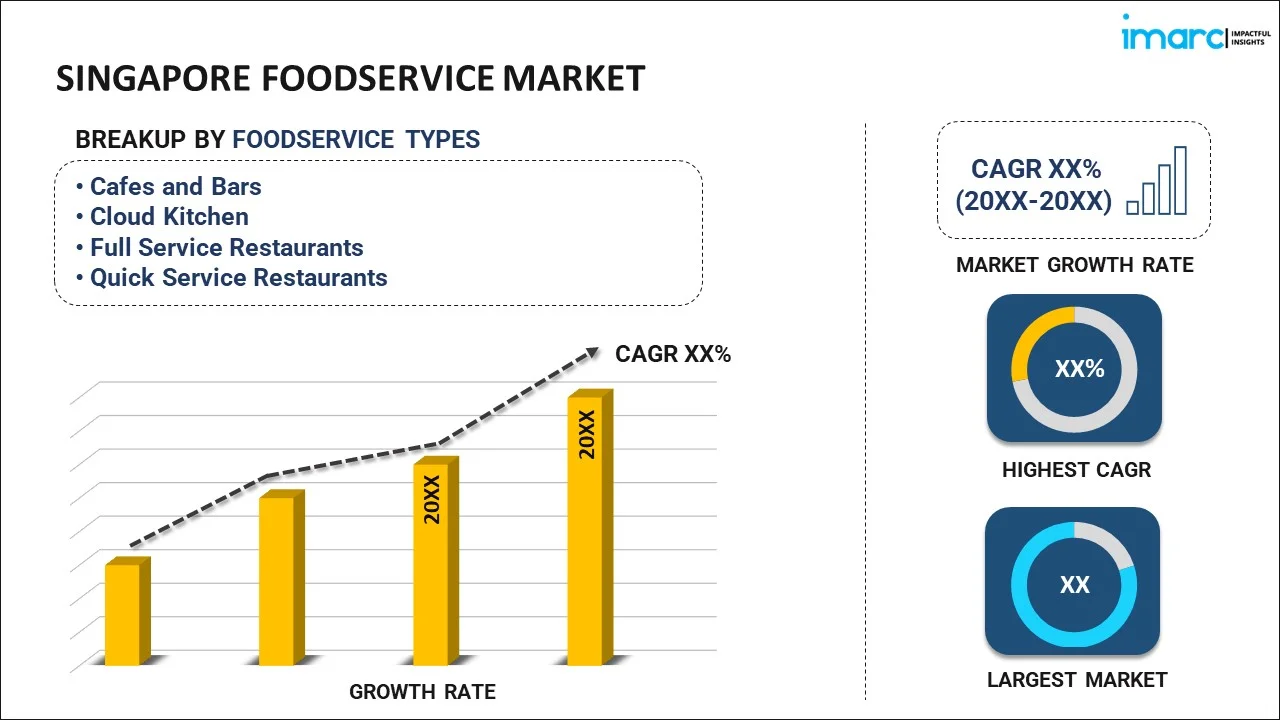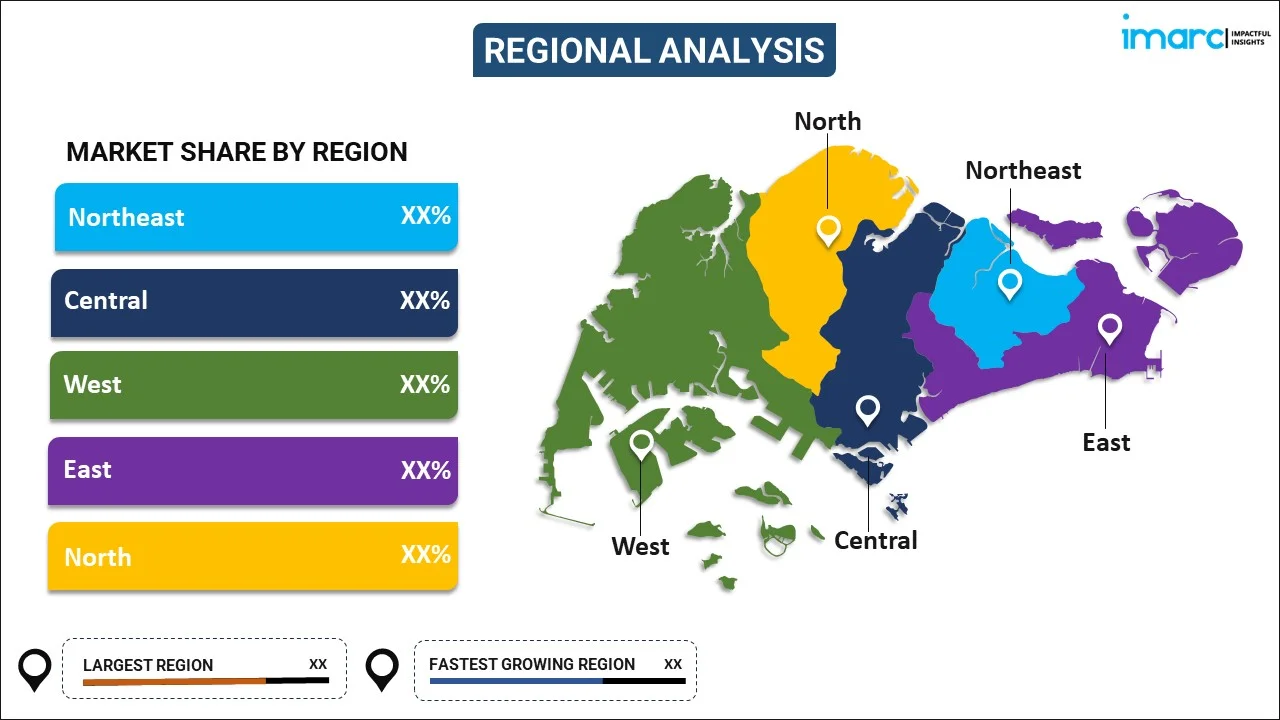
Singapore Foodservice Market Report by Foodservice Type (Cafes and Bars, Cloud Kitchen, Full Service Restaurants, Quick Service Restaurants), Outlet (Chained Outlets, Independent Outlets), Location (Leisure, Lodging, Retail, Standalone, Travel), and Region 2024-2032
Singapore Foodservice Market Overview:
The Singapore foodservice market is projected to exhibit a growth rate (CAGR) of 14.50% during 2024-2032. The market is driven by increasing disposable incomes of individuals, rising adoption of technology in the foodservice industry, growing health consciousness among consumers, and the expanding tourism industry.
|
Report Attribute
|
Key Statistics
|
|---|---|
|
Base Year
|
2023 |
|
Forecast Years
|
2024-2032
|
|
Historical Years
|
2018-2023
|
| Market Growth Rate (2024-2032) | 14.50% |
Singapore Foodservice Market Trends:
Rising Disposable Incomes
The foodservice business has experienced a considerable boost due to the increase in disposable income. According to the Singapore Department of Statistics, after increasing by 9.2% in the prior quarter, personal disposable income increased by 10% year over year in the fourth quarter of 2022. Due to this, those who have more money tend to spend a greater percentage of it on leisure activities, such as eating out. People can expand their social horizons and palates by exploring and enjoying a wide range of culinary experiences, from fine dining establishments to street cuisine, thanks to this additional revenue. This trend also heavily depends on urbanization. The fast-paced urban lifestyle often leads to longer working hours and less time for home-cooked meals. As a result, dining out becomes a convenient solution for many urban dwellers who seek quick and easy meal options without the time and effort required for cooking at home. Additionally, the proliferation of dual-income households significantly impacts the foodservice industry. With both partners working, families have less time to prepare meals at home, increasing the demand for dining out or ordering in. This shift is particularly pronounced among busy professionals and families who prioritize convenience and time efficiency.
Expanding Tourism Industry
The growing tourism industry is a major driver of Singapore's foodservice market, drawing millions of visitors each year who come to experience the city's famous culinary scene. As per Singapore Tourism Board, Singapore’s international visitor arrivals (IVA) reached 6.3 million in 2022 (~33% of 2019 IVA), exceeding STB’s forecast of between 4 and 6 million visitors. Tourism receipts (TR) are estimated to reach USD 13.8 to USD 14.3 billion (~50% to 52% of 2019 TR). Singapore is renowned for its diverse and vibrant food culture, which blends influences from Chinese, Malay, Indian, and Western cuisines. This multicultural culinary heritage makes Singapore an attractive destination for food enthusiasts from around the world. The Singapore Tourism Board (STB) plays a crucial role in promoting the city as a premier food destination. Through targeted marketing campaigns, the STB highlights Singapore's unique food offerings, from hawker centers to Michelin-starred restaurants. These campaigns often showcase iconic local dishes such as chili crab, Hainanese chicken rice, and laksa, enticing potential tourists with the promise of unforgettable gastronomic experiences. Furthermore, the STB organizes and supports various food-related events and festivals that draw international attention. Events like the Singapore Food Festival celebrate the city’s culinary diversity and innovation, featuring local chefs, street food vendors, and international culinary talents.
Singapore Foodservice Market News:
- In February 2024, Delivery Hero SE (“Delivery Hero”, the “Company” or the “Group”), the world’s leading local delivery platform, announced that it has terminated discussions with the main negotiating counterpart regarding a potential sale of its foodpanda business in selected Southeast Asian markets covering Singapore, Malaysia, the Philippines, Thailand, Cambodia, Myanmar and Laos.
- In July 2024, Singapore’s ride-hailing and food delivery company Grab is expanding its services beyond ride and food delivery by doubling down on the competitive restaurant booking industry in Southeast Asia. Grab confirmed that it acquired a Singapore-based dining reservation platform, Chope, for an undisclosed amount.
Singapore Foodservice Market Segmentation:
IMARC Group provides an analysis of the key trends in each segment of the market, along with forecasts at the country level for 2024-2032. Our report has categorized the market based on foodservice type, outlet, and location.
Foodservice Type Insights:

- Cafes and Bars
- By Cuisine
- Bars and Pubs
- Cafes
- Juice/Smoothie/Desserts Bars
- Specialist Coffee and Tea Shops
- By Cuisine
- Cloud Kitchen
- Full Service Restaurants
- By Cuisine
- Asian
- European
- Latin American
- Middle Eastern
- North American
- Others
- By Cuisine
- Quick Service Restaurants
- By Cuisine
- Bakeries
- Burger
- Ice Cream
- Meat-based Cuisines
- Pizza
- Others
- By Cuisine
The report has provided a detailed breakup and analysis of the market based on the foodservice type. This includes cafes and bars (bars and pubs, cafes, juice/smoothie/desserts bars, and specialist coffee and tea shops), cloud kitchen, full service restaurants (asian, european, latin american, middle eastern, north american, and others), and quick service restaurants (bakeries, burger, ice cream, meat-based cuisines, pizza, and others).
Outlet Insights:
- Chained Outlets
- Independent Outlets
A detailed breakup and analysis of the market based on the outlet have also been provided in the report. This includes chained outlets and independent outlets.
Location Insights:
- Leisure
- Lodging
- Retail
- Standalone
- Travel
The report has provided a detailed breakup and analysis of the market based on the location. This includes leisure, lodging, retail, standalone, and travel.
Regional Insights:

- North-East
- Central
- West
- East
- North
The report has also provided a comprehensive analysis of all the major regional markets, which include North-East, Central, West, East, and North.
Competitive Landscape:
The market research report has also provided a comprehensive analysis of the competitive landscape. Competitive analysis such as market structure, key player positioning, top winning strategies, competitive dashboard, and company evaluation quadrant has been covered in the report. Also, detailed profiles of all major companies have been provided.
Singapore Foodservice Market Report Coverage:
| Report Features | Details |
|---|---|
| Base Year of the Analysis | 2023 |
| Historical Period | 2018-2023 |
| Forecast Period | 2024-2032 |
| Units | Billion US$ |
| Scope of the Report | Exploration of Historical Trends and Market Outlook, Industry Catalysts and Challenges, Segment-Wise Historical and Future Market Assessment:
|
| Foodservice Types Covered |
|
| Outlets Covered | Chained Outlets, Independent Outlets |
| Locations Covered | Leisure, Lodging, Retail, Standalone, Travel |
| Regions Covered | North-East, Central, West, East, North |
| Customization Scope | 10% Free Customization |
| Post-Sale Analyst Support | 10-12 Weeks |
| Delivery Format | PDF and Excel through Email (We can also provide the editable version of the report in PPT/Word format on special request) |
Key Questions Answered in This Report:
- How has the Singapore foodservice market performed so far and how will it perform in the coming years?
- What has been the impact of COVID-19 on the Singapore foodservice market?
- What is the breakup of the Singapore foodservice market on the basis of foodservice type?
- What is the breakup of the Singapore foodservice market on the basis of outlet?
- What is the breakup of the Singapore foodservice market on the basis of location?
- What are the various stages in the value chain of the Singapore foodservice market?
- What are the key driving factors and challenges in the Singapore foodservice?
- What is the structure of the Singapore foodservice market and who are the key players?
- What is the degree of competition in the Singapore foodservice market?
Key Benefits for Stakeholders:
- IMARC’s industry report offers a comprehensive quantitative analysis of various market segments, historical and current market trends, market forecasts, and dynamics of the Singapore foodservice market from 2018-2032.
- The research report provides the latest information on the market drivers, challenges, and opportunities in the Singapore foodservice market.
- Porter's five forces analysis assist stakeholders in assessing the impact of new entrants, competitive rivalry, supplier power, buyer power, and the threat of substitution. It helps stakeholders to analyze the level of competition within the Singapore foodservice industry and its attractiveness.
- Competitive landscape allows stakeholders to understand their competitive environment and provides an insight into the current positions of key players in the market.
Need more help?
- Speak to our experienced analysts for insights on the current market scenarios.
- Include additional segments and countries to customize the report as per your requirement.
- Gain an unparalleled competitive advantage in your domain by understanding how to utilize the report and positively impacting your operations and revenue.
- For further assistance, please connect with our analysts.
 Inquire Before Buying
Inquire Before Buying
 Speak to an Analyst
Speak to an Analyst
 Request Brochure
Request Brochure
 Request Customization
Request Customization




.webp)




.webp)












